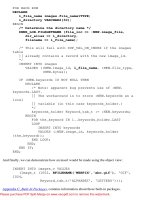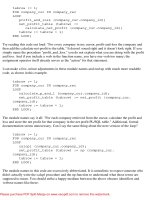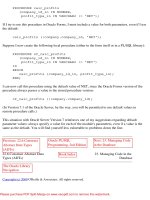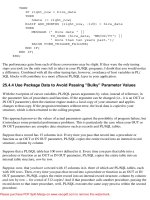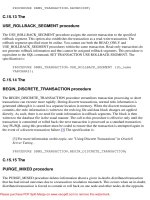Oracle PLSQL Language- P24
Bạn đang xem bản rút gọn của tài liệu. Xem và tải ngay bản đầy đủ của tài liệu tại đây (148.17 KB, 50 trang )
tabrow := 1;
FOR company_cur IN company_rec
LOOP
profit_and_loss (company_cur.company_id);
net_profit_table (tabrow) :=
calculate_net_profit (company_cur.company_id);
tabrow := tabrow + 1;
END LOOP;
Try reading this code out loud: "For every company in my cursor, profit-and-loss the company and
then add the calculate-net-profit to the table." It doesn't sound right and it doesn't look right. If you
simply name the procedure "profit_and_loss," you do not explain what you are doing with the profit
and loss. And if you include a verb in the function name, you have one verb too many; the
assignment operator itself already serves as the "action" for that statement.
I can make a few, minor adjustments in these module names and end up with much more readable
code, as shown in this example:
tabrow := 1;
FOR company_cur IN company_rec
LOOP
calculate_p_and_l (company_cur.company_id);
net_profit_table (tabrow) := net_profit (company_cur.
company_id);
tabrow := tabrow + 1;
END LOOP;
The module names say it all: "For each company retrieved from the cursor, calculate the profit and
loss and store the net profit for that company in the net profit PL/SQL table." Additional, formal
documentation seems unnecessary. Can I say the same thing about the next version of the loop?
tabrow := 1;
FOR company_cur IN company_rec
LOOP
calcpl (company_cur.company_id);
net_profit_table (tabrow) := np (company_cur.
company_id);
tabrow := tabrow + 1;
END LOOP;
The module names in this code are excessively abbreviated. It is unrealistic to expect someone who
didn't actually write the calcpl procedure and the np function to understand what those terms are
supposed to mean. You should strike a happy medium between the above obscure identifiers and
verbose names like these:
Please purchase PDF Split-Merge on www.verypdf.com to remove this watermark.
calculate_profit_and_loss_per_company
net_profit_for_single_company
Don't forget that you or someone else will have to type those program names!
22.1.2 Develop Consistent Naming Conventions for Your Formal
Parameters
A parameter plays a specific role within a program; its name should indicate this difference. I
recommend that in order to further distinguish parameters from other PL/SQL identifiers you include
the parameter mode right in the name of the formal parameter.
A parameter has one of three modes: IN, OUT, or IN OUT. An IN parameter passes a value into the
module, but its value cannot be modified. An OUT parameter passes a value out of the module, but
its value cannot be referenced in the module. An IN OUT parameter can be both referenced and
modified in the module.
By incorporating the parameter mode directly into the parameter name, its purpose in the module is
self-documenting. Whenever you encounter that parameter in the code, you know that you are
looking at a parameter, not a local variable, and you know exactly the ways in which that parameter
can be used and/or changed.
In order for the parameter mode to stand out in the formal parameter name, you can include it either
as a suffix or as a prefix. As a suffix, the mode is appended to the end of the parameter name, as
follows:
PROCEDURE combine_and_format_names
(first_name_inout IN OUT VARCHAR2,
last_name_inout IN OUT VARCHAR2,
full_name_out OUT VARCHAR2,
name_format_in IN VARCHAR2 := 'LAST,FIRST');
The prefix standard would result in a parameter list for the above procedure as follows:
PROCEDURE combine_and_format_names
(inout_first_name IN OUT VARCHAR2,
inout_last_name IN OUT VARCHAR2,
out_full_name OUT VARCHAR2,
in_name_format IN VARCHAR2 := 'LAST,FIRST') ;
You could also opt for a minimum of typing by simply using the first letter of each parameter mode:
PROCEDURE combine_and_format_names
(io_first_name IN OUT VARCHAR2,
Please purchase PDF Split-Merge on www.verypdf.com to remove this watermark.
io_last_name IN OUT VARCHAR2,
o_full_name OUT VARCHAR2,
i_name_format IN VARCHAR2 := 'LAST,FIRST') ;
In any of these cases, a quick glance over the code identifies which objects represent parameters in
the program. You can also more easily catch logic errors, such as the following case of an illegal
update of an IN parameter:
in_name_format := 'FIRST MIDDLE LAST';
A parameter with an "in" suffix or prefix should never have its value changed. A parameter with an
"out" suffix or prefix should never be used on the right-hand side of an assignment because its value
is indeterminate in the program (until it is given a value).
22.1.3 Name Packages and Their Elements to Reflect the Packaged
Structure
Given that a package provides a new layer or context over the normal variables and modules, you
should take some special care in naming your packages and the elements within them. The name you
use for a standalone module, in particular, will change when you move it inside a package. Consider
the following example. If I develop a set of standalone procedures and functions to maintain lists of
information, I might name them as follows:
PROCEDURE list_create (list_in IN VARCHAR2);
PROCEDURE list_get
(list_in IN VARCHAR2, position_in IN NUMBER, item_out
OUT VARCHAR2);
and so on. I need to use the "list_" prefix in front of each module name so that the name clearly
identifies the structure for the action.
Suppose I now move modules like these inside the scope of a package called "list." The specification
for the package looks like this:
PACKAGE list
IS
PROCEDURE list_create (list_in IN VARCHAR2);
PROCEDURE list_get
(list_in IN VARCHAR2, position_in IN NUMBER,
item_out OUT VARCHAR2);
END list;
At first glance this looks reasonable enough. The real test, however, comes when you try to use the
modules. Let's try it. To create a list using the package procedure, I would execute a statement like
Please purchase PDF Split-Merge on www.verypdf.com to remove this watermark.
this:
list_pkg.list_create ('company_names');
Now, that looks silly. The "list" is mentioned in both the package name and the module name. It
didn't make much sense to carry over the standalone module names to the package names. A much
cleaner naming scheme should produce executable statements that remove the redundancies:
PACKAGE list_pkg
IS
PROCEDURE create (list_in IN VARCHAR2);
PROCEDURE get
(list_in IN VARCHAR2, position_in IN NUMBER,
item_out OUT VARCHAR2);
END list_pkg;
list.create ('company_names');
As you define modules in a package, always think of them within the context of the package. If a
package is supposed to maintain lists, then the name of the package should reflect that general
purpose. The names of the individual modules ought to focus on their particular purpose -- again,
within the broader orientation of the package.
You might also consider setting as a standard the use of a _pkg suffix for all package names. With
this approach, the list package and calls to the package look like this:
PACKAGE list_pkg
IS
PROCEDURE create (list_in IN VARCHAR2);
PROCEDURE get
(list_in IN VARCHAR2, position_in IN NUMBER,
item_out OUT VARCHAR2);
END list_pkg;
list_pkg.create ('company_names');
Personally, I have mixed feelings about this naming convention. It is important and useful to include
information about the type of data in the name of the data, and I certainly encourage such a
convention with cursors, records, tables, etc. A package, however, is a different sort of animal. It
contains all those other language constructs. The way in which the package name is used to qualify
the object already tells you what it is. It seems to me that inclusion of the _pkg suffix (or other
indicator) reduces the readability of the code.
Please purchase PDF Split-Merge on www.verypdf.com to remove this watermark.
Previous: VI. Making PL/
SQL Programs Work
Oracle PL/SQL
Programming, 2nd Edition
Next: 22.2 Build the Most
Functional Functions
VI. Making PL/SQL
Programs Work
Book Index
22.2 Build the Most
Functional Functions
The Oracle Library
Navigation
Copyright (c) 2000 O'Reilly & Associates. All rights reserved.
Please purchase PDF Split-Merge on www.verypdf.com to remove this watermark.
Previous: 22.1 Select
Meaningful Module and
Parameter Names
Chapter 22
Code Design Tips
Next: 22.3 Take Full
Advantage of Local
Modularization
22.2 Build the Most Functional Functions
I like functions. They can replace an awful lot of complex logic in an expression with a simple
statement of the result of all that logic. The following tips will help you construct functions that are as
useful as possible.
22.2.1 Avoid Side Effects in Functions
Your function has one purpose in life: returning a single value via the RETURN statement. If it does
anything else, such as update global or database information, then that function has potentially
created a side effect. Side effects generally limit functions' usefulness. Let's look at a few examples
and discuss how you can avoid side effects.
22.2.1.1 Do not use OUT and IN OUT parameters
Although a function returns its value with the RETURN statement, PL/SQL allows you to define
OUT and IN OUT parameters for a function. If you do that, the function can actually pass changed
data back through the parameter itself into the calling block of code through the parameters. This is
generally not a good idea, and is a typical side effect in a function.
The format_name function below contains side effect parameters. Let's examine the impact of these
parameters. The function takes a first name and a last name and returns a full name with the format
LAST, FIRST. Because a requirement of the application happens to be that all names must be in
uppercase, the function also converts the first and last names to their uppercase versions. It uses two
IN OUT parameters to do this.
FUNCTION format_name
(first_name_inout IN OUT VARCHAR2,
last_name_inout IN OUT VARCHAR2)
RETURN VARCHAR2
IS
BEGIN
first_name_inout := UPPER (first_name_inout);
Please purchase PDF Split-Merge on www.verypdf.com to remove this watermark.
last_name_inout := UPPER (last_name_inout);
RETURN last_name_inout || ', ' || first_name_inout;
END;
If the application requires uppercase names, you may wonder, then, what is wrong with converting
the first and last names to uppercase in format_name? First of all, this approach may be trying to
meet the requirement a bit too enthusiastically. If the formatted name -- the output, that is, of the
function -- must be in uppercase, you can certainly accomplish that without modifying the
parameters, as follows:
FUNCTION format_name
(first_name_in IN VARCHAR2,
last_name_in IN VARCHAR2)
RETURN VARCHAR2
IS
BEGIN
RETURN UPPER (last_name_in || ', ' || first_name_in);
END;
The second reason you would not want to automatically uppercase the name components is that you
will make format_name less useful as a basic utility. Your current application may insist on
uppercase, but there will be plenty of other applications that maintain entities having first and last
names -- and they do not have a similar requirement.
If you insist on the IN OUT parameters, the format_name utility could not be used in these other
application development efforts.
22.2.1.2 Switch to a procedure with IN OUT parameters
If you do want a module that will convert both individual name components and the combined name
to uppercase, then you would be better served with a procedure:
PROCEDURE combine_and_format_names
(first_name_inout IN OUT VARCHAR2,
last_name_inout IN OUT VARCHAR2,
full_name_out OUT VARCHAR2)
IS
BEGIN
first_name_inout := UPPER (first_name_inout);
last_name_inout := UPPER (last_name_inout);
full_name_out := last_name_inout || ', ' ||
first_name_inout;
END;
By using a procedure, you make it clearer that the module is applying changes to all the parameters.
Please purchase PDF Split-Merge on www.verypdf.com to remove this watermark.
You avoid providing a function with side effects (i.e., other actions and impact beyond the return of a
value). Let's take a look at the way these different modules would appear in your code.
●
Let's first look at the function version. All our attention is focused on depositing the formatted
name into the caller_name item:
full_name := format_name (first_name, :last_name);
●
Now let's look at the procedure version. The use of the plural of "name" in the name of the
procedure indicates a change to more than one of the parameters:
combine_and_format_names (first_name, last_name,
full_name);
Generally speaking, when your function has a side effect such as the uppercasing of the parameter
values, that function is less broadly useful. What if programmers don't want to have the other values
uppercased? They would have to write their own function that does the same thing as format_name,
but without the UPPER statements. This code redundancy will create nightmares down the road. If
the function is supposed to return a formatted name based on the first and last names, then that is all it
should do -- never use OUT and IN OUT parameters with a function.
22.2.1.3 Don't interact with users
Such parameters are not the only kinds of side effects you may be tempted to slip into a function.
Consider this Oracle Forms function, which retrieves the name of a company from its primary key:
FUNCTION company_name (company_id_in IN company.company_id
%TYPE)
RETURN VARCHAR2
IS
CURSOR name_cur IS
SELECT name FROM company
WHERE company_id = company_id_in;
name_rec name_cur%ROWTYPE;
BEGIN
OPEN name_cur;
FETCH name_cur INTO name_rec;
IF name_cur%FOUND
THEN
CLOSE name_cur;
RETURN name_rec.name;
ELSE
BELL;
MESSAGE ('Invalid company ID: ' || TO_CHAR
(company_id_in),
Please purchase PDF Split-Merge on www.verypdf.com to remove this watermark.
ACKNOWLEDGE);
RAISE FORM_TRIGGER_FAILURE;
END IF;
END;
When the company ID returns an existing company, the function properly closes the cursor and
returns the company's name. When the SELECT statement comes up empty, however, I change my
approach completely. Rather than return a value, I go into the equivalent of PL/SQL panic mode: ring
the bell, display a message (and force the user to acknowledge that message), and then fail out of the
calling trigger. I don't even close the cursor! Rather strong stuff, and very much out of place in this
function.
My response to invalid data is a side effect in the function, made all the worse by the fact that my
side effect completely substitutes for a RETURN. When the company ID does not find a match, I do
not execute a RETURN statement at all.
The consequences of my error handling in this function are:
●
This function can be called only in Oracle Forms. It is, however, a fairly generic task: take a
primary key and return a name/description. It could be a function stored in the database and
available to any program that needs to perform the lookup. I have now made that impossible.
●
Anyone who calls this function gives up control over his or her own program. You cannot
decide for yourself what to do if the name is not found. That message is displayed whether or
not it is appropriate. That bell sounds even if users don't like to announce to everyone around
them that they made a mistake. The best you can do is code an exception handler for
FORM_TRIGGER_FAILURE in whatever trigger or program calls company_name.
A much better approach to the company_name function is simply to return a NULL value if the
company is not found. Since the company name is a NOT NULL column, a NULL return value
clearly indicates "no data found." This new approach is shown in the following example:
FUNCTION company_name (company_id_in IN company.company_id
%TYPE)
RETURN VARCHAR2
IS
CURSOR name_cur IS
SELECT name FROM company
WHERE company_id = company_id_in;
name_rec name_cur%ROWTYPE;
no_company_found EXCEPTION;
BEGIN
OPEN name_cur;
FETCH name_cur INTO name_rec;
IF name_cur%FOUND
Please purchase PDF Split-Merge on www.verypdf.com to remove this watermark.
THEN
CLOSE name_cur;
RETURN name_rec.name;
ELSE
RAISE no_company_found;
END IF;
EXCEPTION
WHEN no_company_found OR OTHERS
THEN
CLOSE name_cur;
RETURN NULL;
END;
This is now a nonjudgmental, mind-your-own-business function. It doesn't try to dictate the terms of
surrender, or tell programmers who call it how they should handle a lack of data. It simply reports
back the problem by returning a NULL value. Users of the function may then decide for themselves
on an appropriate consequence, which might well consist of every action formerly embedded in the
function itself:
new_company := company_name (:company.company_id);
IF new_company IS NULL
THEN
BELL;
MESSAGE
('Invalid company ID: ' || TO_CHAR (:company.
company_id),
ACKNOWLEDGE);
RAISE FORM_TRIGGER_FAILURE;
END IF;
At least now the programmer has freedom of choice.
Side effects in functions come in many shapes and flavors. If you remember to keep the focus of the
function on computing and returning its value, the resulting module will be more effectively and
widely used.
22.2.2 Use a Single RETURN Statement for Successful Termination
A function exists to return a single value. The best way to structurally emphasize this single-minded
focus in the body of the function is to make sure that the only RETURN statement in the execution
section of the function is the last executable statement. Consider the following code-translating
function:
FUNCTION status_desc (status_cd_in IN VARCHAR2) RETURN
VARCHAR2
Please purchase PDF Split-Merge on www.verypdf.com to remove this watermark.
IS
BEGIN
IF status_cd_in = 'C' THEN RETURN 'CLOSED';
ELSIF status_cd_in = 'O' THEN RETURN 'OPEN';
ELSIF status_cd_in = 'A' THEN RETURN 'ACTIVE';
ELSIF status_cd_in = 'I' THEN RETURN 'INACTIVE';
END IF;
END;
Each of the different RETURN statements is actually a different exit point in this function. You are
now probably saying to yourself, "This is such a simple program. What's wrong with using the
different RETURN statements?"
Granted, the program is straightforward and short enough so that, at a glance, you understand its
purpose and follow the exit flow. Unfortunately, it also is prone to failure. What if the status code that
is passed into status_desc is not one of C, O, A, or I? Then the function does not even execute a
RETURN statement, leaving the calling program with indeterminate results. Now examine the
version of status_desc that relies on a single RETURN:
FUNCTION status_desc (status_cd_in IN VARCHAR2) RETURN
VARCHAR2
IS
return_value VARCHAR2 (20) := NULL;
BEGIN
IF status_cd_in = 'C' THEN return_value := 'CLOSED';
ELSIF status_cd_in = 'O' THEN return_value := 'OPEN';
ELSIF status_cd_in = 'A' THEN return_value := 'ACTIVE';
ELSIF status_cd_in = 'I' THEN return_value :=
'INACTIVE';
END IF;
RETURN return_value;
END;
Here, my IF statement assigns the description to a local variable. After the IF statement, the
RETURN statement serves its purpose in life, which is to pass the value of the variable back to the
calling program. Because I initialize the temporary description to NULL, if the status code is not one
of the chosen four, then I return NULL. In any case, the result is that, by placing the RETURN
statement at the last line of the execution section of the function, I always execute a RETURN
statement when the function completes successfully. There are no holes in my return logic.
This approach is absolutely critical when your function is more elaborate and longer than 10 or 20
lines in length, perhaps even hundreds of lines long. It can be very difficult to follow multi-page
complex logic, and nearly impossible to confirm, simply by reading the code, that the function
always issues a RETURN statement for all branches of the logic. Your application works much more
reliably if you build right into it the requirement that the only RETURN statement in the function
Please purchase PDF Split-Merge on www.verypdf.com to remove this watermark.
occurs at the end of the program.
22.2.2.1 Build a function template
I realize that it is one thing to read through all of the tips in this book and, as you read them, nod in
agreement with their wisdom. It is quite another thing to both remember the tips and make the time to
put them to use in your code. The best way I have found to at least improve the chances that I follow
even my own advice is to set hard and fast rules -- and then stick to them. When it comes to "Use a
single RETURN statement for successful termination," I try to always follow two simple rules when
creating a function:
●
Always declare a local variable named "return_value" with a datatype that matches the
RETURN clause of the function. If I am returning a VARCHAR2, declare a VARCHAR2
local variable. If I am returning data with the same datatype as a table column, declare that.
Here are two examples:
FUNCTION net_sales (company_id_in IN company.
company_id%TYPE)
RETURN NUMBER
IS
return_value NUMBER;
BEGIN
...
END;
or:
FUNCTION company_name (company_id_in IN company.
company_id%TYPE)
RETURN company.name%TYPE
IS
return_value company.name%TYPE;
BEGIN
...
END;
●
Always make the last executable statement of my function the RETURN statement as follows:
RETURN return_value;
By following these two rules, the general structure of my function now looks like this:
FUNCTION function_name (parameter_list) RETURN datatype
IS
return_value datatype;
BEGIN
... executable code of function ...
Please purchase PDF Split-Merge on www.verypdf.com to remove this watermark.
RETURN return_value;
EXCEPTION
... optional exception section ...
END;
The name of the local variable states quite clearly that it is standing in for the data that is to be
returned by the function. Any time this return_value variable is assigned a value in the function, you
know that the function is fulfilling its purpose of generating a value to be returned with the RETURN
statement. It provides a clean, understandable, and predictable structure for the function. I have even
gone so far as to create a template script on disk that implements this guideline. It looks like this:
/* Filename on companion disk: functmpl.sf */
CREATE OR REPLACE FUNCTION fname () RETURN datatype
IS
return_value datatype;
BEGIN
RETURN return_value;
END fname;
Then I just have to search-and-replace on "fname" and "datatype" and I am all ready to go.
22.2.2.2 Exception handling
One exception to the rule of a single RETURN statement in a function concerns exception handling.
A function should return a value, whether it completes successfully or it fails. Upon successful
completion, you can use the above structure to guarantee that the RETURN executes. What if the
function fails? Any exception handler in a function should have as its last executable statement a
RETURN of its own, as this example shows:
FUNCTION present_value
(FV IN NUMBER, interest_rate IN NUMBER, period IN
NUMBER)
RETURN NUMBER
IS
return_value NUMBER;
negative_value EXCEPTION;
BEGIN
return_value := FV / ((1 + interest_rate)**period);
IF return_value < 0
THEN
RAISE negative_value;
ELSE
RETURN return_value;
END IF;
Please purchase PDF Split-Merge on www.verypdf.com to remove this watermark.
EXCEPTION
WHEN negative_value
THEN
RETURN 0;
WHEN OTHERS
THEN
RETURN NULL;
END;
When each handler has its own RETURN statement, you can be sure that the function returns a value
regardless of the way it is terminated. The present_value function also illustrates another important
principle: if the program encounters an error, always call an exception handler to deal with the
problem. Do not process the error inline. PL/SQL provides a very structured distinction between the
executable body of the program and the exception section. As soon as you hit an error or logical
exception to normal processing, RAISE an exception to transfer control out of normal execution.
22.2.3 Avoid Exception Handlers for Normal Program Exits
There is always only one entry point for a module: the first executable statement is always the one
that follows the BEGIN statement. PL/SQL does not allow you to enter a block at an arbitrary line of
code. The same cannot be said, however, for the way in which a module terminates. A PL/SQL
program unit may complete its execution either through the last executable statement, a RETURN
statement, or the exception handler section, as is appropriate:
●
The last executable statement in a program is the normal exit point for a procedure.
●
The RETURN statement is the normal exit point for a function.
●
The exception section is the way out of a module that has hit an error and raised an exception.
A programming language like PL/SQL is constructed very carefully: every keyword and element of
syntax is chosen with a specific purpose. Although you can at times justify using a language construct
in an unorthodox way, in most cases such an action will raise a red flag and be closely examined. One
example of such linguistic abuse occurs when a programmer uses an exception handler to perform a
normal program exit. Here is an example:
FUNCTION company_name (company_id_in IN company.company_id
%TYPE)
RETURN VARCHAR2
IS
cname company.company_id%TYPE;
found_it EXCEPTION;
BEGIN
SELECT name INTO cname FROM company
WHERE company_id = company_id_in;
RAISE found_it;
Please purchase PDF Split-Merge on www.verypdf.com to remove this watermark.
EXCEPTION
WHEN NO_DATA_FOUND
THEN
RETURN NULL;
WHEN found_it
THEN
RETURN cname;
END;
In this function the programmer uses an implicit cursor to try to find the company that matches the
incoming primary key. If no record is found, the program properly handles the NO_DATA_FOUND
exception and returns NULL. But if a record is returned, then the program RAISEs an exception,
which in turn returns the company name selected.
The found_it exception is not an exception at all. It indicates successful completion of the program.
Rather than use an exception, the function should simply issue a RETURN with cname, indicating
that the SELECT was successful:
FUNCTION company_name (company_id_in IN company.company_id
%TYPE)
RETURN VARCHAR2
IS
cname company.company_id%TYPE;
BEGIN
SELECT name INTO cname FROM company
WHERE company_id = company_id_in;
RETURN cname;
EXCEPTION
WHEN NO_DATA_FOUND THEN RETURN NULL;
END;
In this case the replacement of the RAISE with a RETURN was obvious and straightforward; no
other code changes were required. In other situations, it can take much more effort to undo the poor
programming practices of others. It is much better to do the job right the first time!
Programmers are often tempted to use the RAISE statement because it acts like a GOTO: it
immediately halts execution of the program and transfers control to the exception section. This
GOTO-like behavior can be very convenient when a programmer cannot figure out how to use IF
statements in a structured way to neatly end the program. In this case, the RAISE statement becomes
an easy way out.
If you find yourself writing programs that rely on the RAISE statement to do something besides
handle exceptions, take a step back. Examine the logical flow of the program and explore how you
can use the standard control structures (IF, LOOP, and perhaps even GOTO as a last resort) to
accomplish your task instead.
Please purchase PDF Split-Merge on www.verypdf.com to remove this watermark.
22.2.4 Use Assertion Modules to Validate Parameters and Assumptions
Just about every piece of software you write makes assumptions about the data it manipulates. For
example, parameters may have only certain values or be within a certain range, or a string value
should have a certain format. In both of these cases, an underlying data structure is assumed to have
been created. It's fine to have such rules and assumptions, but it is also very important to verify or
"assert" that none of the rules is being violated.
One approach you can take in this verification process is to make use of the IF statement at the
beginning of your program. The status_desc function shown below uses the conditional construct to
implicitly validate the value of the argument. The function does not actively or explicitly check to see
if the status code argument is one of C, O, A, or I. Instead, the IF statement returns a non-null value
only if a valid code is provided.
FUNCTION status_desc (status_cd_in IN VARCHAR2) RETURN
VARCHAR2
IS
return_value VARCHAR2 (20) := NULL;
BEGIN
IF status_cd_in = 'C' THEN return_value := 'CLOSED';
ELSIF status_cd_in = 'O' THEN return_value := 'OPEN';
ELSIF status_cd_in = 'A' THEN return_value := 'ACTIVE';
ELSIF status_cd_in = 'I' THEN return_value :=
'INACTIVE';
END IF;
RETURN return_value;
END;
The status_desc function does not really assert anything. If the programmer passes an invalid status
code, the function returns NULL. Sometimes this kind of behavior makes sense. Perhaps a status
code other than C, O, A, or I is a valid entry and a NULL description is useful information in the
application. In that case, an assertion of argument validity is not needed.
On the other hand, what if a legal value should always be passed to status_desc? What if a different
value means that a programmer has coded her use of the function improperly? If status_desc is an
"internal" function accessed only by programmers and not intended to handle user input, then an
illegal status code probably reflects a typographical error or a misunderstanding of the program's use.
In this case, the lack of feedback by status_desc on the invalid argument results in hard-to-trace
errors. Because the programmer is not informed of the typographical mistake when it happens, the
problem propagates through other modules before it surfaces.
22.2.4.1 Trap invalid argument values
If the status_desc function is built to accept only four valid entries, then it should raise a red flag
when that rule is broken. The following function shows a version of status_desc that adds an ELSE
Please purchase PDF Split-Merge on www.verypdf.com to remove this watermark.
clause to trap an invalid entry:
FUNCTION status_desc (status_cd_in IN VARCHAR2) RETURN
VARCHAR2
IS
return_value VARCHAR2 (20) := NULL;
BEGIN
IF status_cd_in = 'C' THEN return_value := 'CLOSED';
ELSIF status_cd_in = 'O' THEN return_value := 'OPEN';
ELSIF status_cd_in = 'A' THEN return_value := 'ACTIVE';
ELSIF status_cd_in = 'I' THEN return_value :=
'INACTIVE';
ELSE
MESSAGE ('Invalid status code: ' || status_cd_in);
RAISE FORM_TRIGGER_FAILURE;
END IF;
RETURN return_value;
END;
With this new version, programmers get immediate feedback if they pass an illegal value to
status_desc. That problem is solved, but I personally find this solution less than totally satisfactory.
Since it forces me to add several lines of code to the body of my program -- lines that were added
simply to handle values that never should have gotten into the program -- this approach is somewhat
intrusive and inelegant. Consider the alternative below:
FUNCTION status_desc (status_cd_in IN VARCHAR2) RETURN
VARCHAR2
IS
return_value VARCHAR2 (20) := NULL;
BEGIN
/* Assert that the status code is valid */
assert_condition (status_cd_in IN ('C', 'O', 'A',
'I'));
/* Now perform processing of valid argument. */
IF status_cd_in = 'C' THEN return_value := 'CLOSED';
ELSIF status_cd_in = 'O' THEN return_value := 'OPEN';
ELSIF status_cd_in = 'A' THEN return_value := 'ACTIVE';
ELSIF status_cd_in = 'I' THEN return_value :=
'INACTIVE';
END IF;
RETURN return_value;
END;
Please purchase PDF Split-Merge on www.verypdf.com to remove this watermark.
The procedure, assert_condition, looks like this:
PROCEDURE assert_condition (condition_in IN BOOLEAN)
IS
BEGIN
IF NOT condition_in
THEN
/* Uses generic PL/SQL exception */
RAISE VALUE_ERROR;
END IF;
END;
Now the first line of my program is a call to a very general assertion module. I pass the condition,
which must evaluate to TRUE in order for the assumptions to hold. In this case the condition was a
fairly complex Boolean expression:
status_cd_in IN ('C', 'O', 'A', 'I')
This kind of a program is called an assertion module because its single Boolean parameter asserts
that a condition is true, and leaves it to the module to reject that claim. Clearly, there isn't much to
assert_condition. It just hides an IF statement behind a procedural interface. Yet, by including the call
to assert_condition, I can let the remainder of the body of my program concentrate on handling the
valid data properly. I do not have to include special handling for illegal values.
Because assert_condition is very generic, I can use it in any program that has a condition I can
express in a single Boolean expression. I don't have to code special nested logic repeatedly. I tell
assert_condition what rule I want to test, and leave it to the module to take action (raise an exception)
when necessary.
22.2.4.2 An application-specific assertion module
Of course, you can build less generic versions of assert_condition. The next function shows an
assertion module for Oracle Forms that displays an optional message to the screen:
PROCEDURE assert_condition
(condition_in IN BOOLEAN, message_in IN VARCHAR2 :=
NULL)
IS
BEGIN
IF NOT condition_in
THEN
/* Use NVL to substitute default message if not
provided. */
MESSAGE (NVL (message_in, 'Check Condition
Failure!'));
Please purchase PDF Split-Merge on www.verypdf.com to remove this watermark.
/* Raise an exception specific to Oracle Forms. */
RAISE FORM_TRIGGER_FAILURE;
END IF;
END;
You can even produce assertion modules that handle very specific kinds of conditions. If you do a lot
of work with record groups in Oracle Forms, you find yourself checking repeatedly at the beginning
of your program to see that the name or handle for the record group points to a valid record group.
You do this with the ID_NULL and FIND_GROUP built-ins, as follows:
IF ID_NULL (FIND_GROUP ('monthly_sales'))
THEN
MESSAGE ('Record group does not exist!');
RAISE FORM_TRIGGER_FAILURE;
ELSE
FOR month_count IN 1 .. GET_GROUP_ROW_COUNT
('monthly_sales')
LOOP
... process monthly data ...
END LOOP;
END IF;
Again, rather than write these statements over and over in each of your programs, you can bundle
them into a standalone module, as shown below:
assert_valid_group ('monthly_sales');
FOR month_count IN 1 .. GET_GROUP_ROW_COUNT
('monthly_sales')
LOOP
... process monthly data ...
END LOOP;
Then simply call that assertion program:
PROCEDURE assert_valid_group (rg_name_in IN VARCHAR2)
/*
|| Assertion: if there is not a valid Id for the record
|| group, display message and raise exception. This is a
|| "design" error; code should not continue executing.
*/
IS
rg_id RECORDGROUP := FIND_GROUP (rg_name_in);
BEGIN
IF ID_NULL (rg_id)
Please purchase PDF Split-Merge on www.verypdf.com to remove this watermark.
THEN
MESSAGE (' Record group '||rg_name_in|| ' is not
defined.');
END IF;
END;
A big advantage of the assertion procedure over the ELSE clause is that it clearly states, at the very
beginning of the module, the assumptions for that program. With the ELSE clause, a failure is a
byproduct of the module's execution. The rule violation is only implied by the structure of the IF
statement and not expressed explicitly.
22.2.4.3 Is an assertion module a side effect?
But wait. If I call assert_condition from within a function and the assertion fails, the function will not
execute a RETURN statement. Doesn't the use of an assertion module violate my guideline to always
return a value from a function? The assert_condition procedure bails out of the calling module (or at
least forces a transfer to the exception section) without any regard for whether a RETURN statement
is needed. Even worse, doesn't the Oracle Forms version containing a MESSAGE statement
contradict my suggestion to avoid side effects in a function?
Yes and no. Yes, I admit that when assert_condition RAISEs its exception, you do not issue a
RETURN statement (unless you code for it yourself in the function, but then you would have to know
which exception was RAISEd by assert_condition). I also admit that the MESSAGE is a side effect in
the function, the main purpose of which is to return a row number in a table.
But I can explain everything, honest!
You see, the point of assert_condition is to test the underlying assumptions in the very structure of
the module. If status_desc is called with an invalid code, that kind of error is very different from, say,
a NO_DATA_FOUND when obtaining the name for a particular company ID number. The
status_desc function as a whole is invalid if it is not passed a valid code. In this context, it doesn't
even make sense to continue processing. The assert_condition procedure uncovers design level errors
in the code that must be corrected before you can even worry about data entry errors or other
application-level concerns.
The logic behind assert_condition is similar to the way Oracle Forms handles level 25 errors when it
executes a form. No matter how high a value you have set for SYSTEM.MESSAGE_LEVEL, Oracle
Forms always halts processing in a form when it encounters a level 25 error, which indicates a design
error in the application.
Previous: 22.1 Select
Meaningful Module and
Parameter Names
Oracle PL/SQL
Programming, 2nd Edition
Next: 22.3 Take Full
Advantage of Local
Modularization
Please purchase PDF Split-Merge on www.verypdf.com to remove this watermark.
